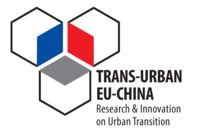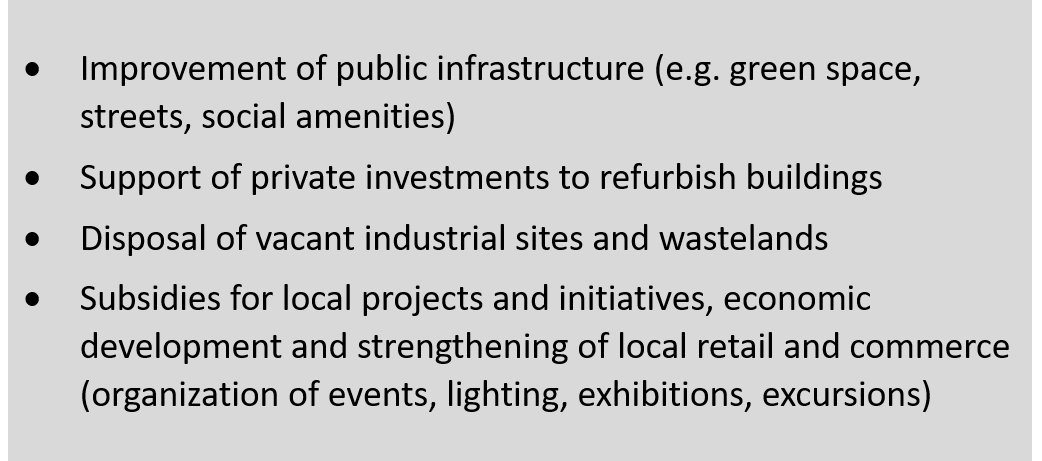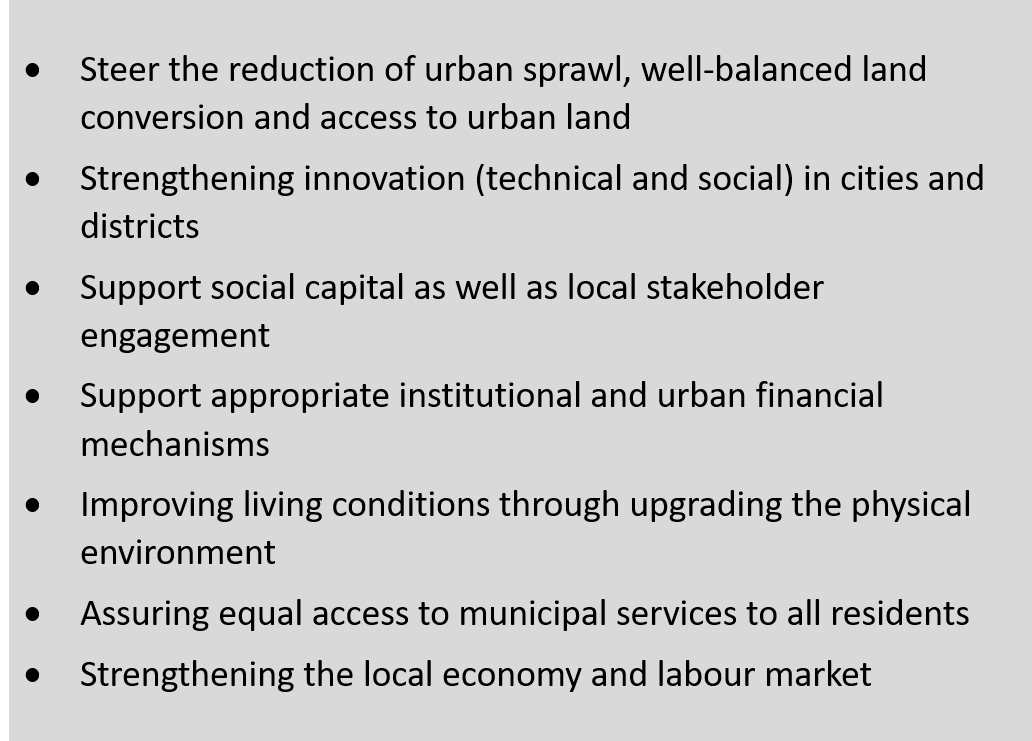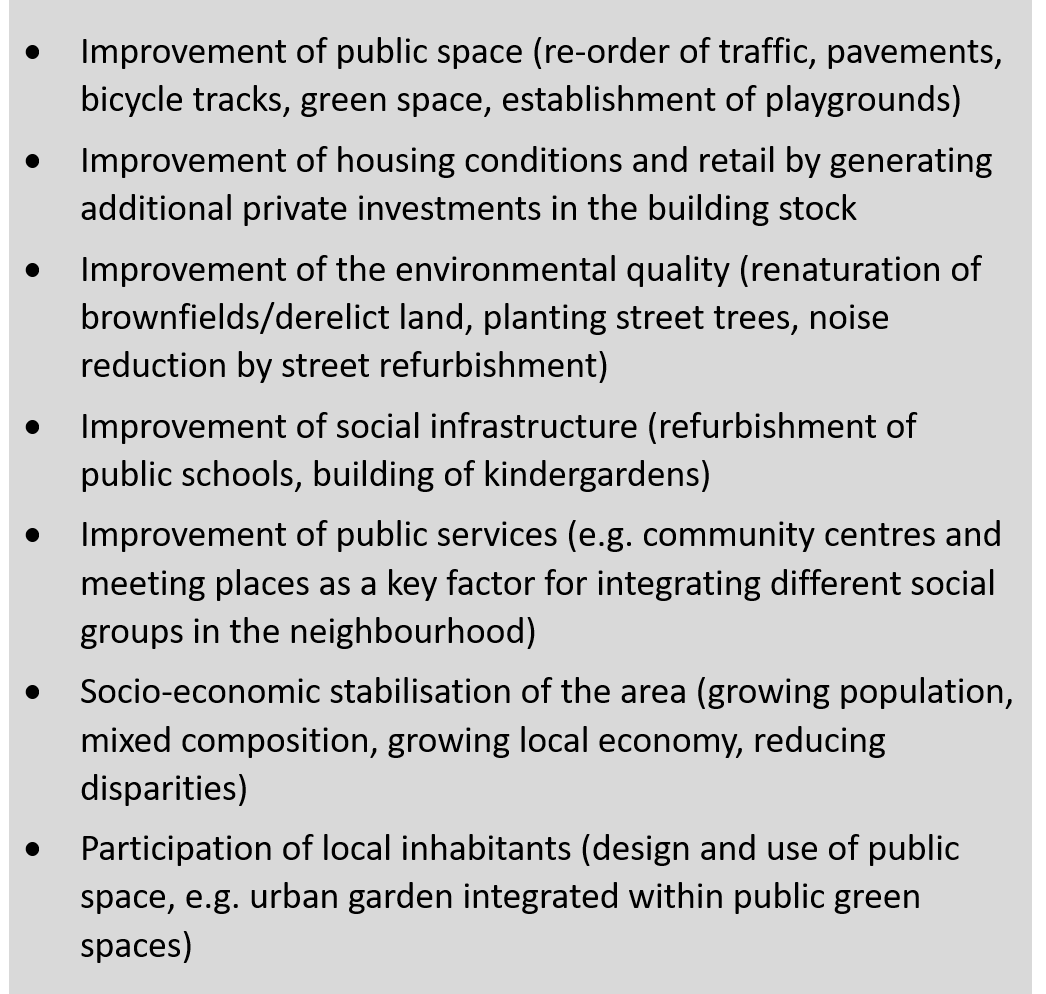
TRANS-URBAN-EU-CHINA
Transition towards urban sustainability through socially integrative cities in the EU and in China
COMPREHENSIVE RENEWAL PROCEDURE (CRP)
1. Purpose(s)
Comprehensive renewal procedures are characterized by a determined set of planning, funding, and legal approaches (including land policy instruments) and a structured procedure to implement renewal activities in a defined urban area.
They are applied in neighbourhoods dealing with manifold socio-economic and physical-environmental urban deficits (Continue reading on People-centered urban regeneration in historic district). Beside high vacancy rates, industrial brownfields/derelict land and run-down residential buildings, these can include an ageing and shrinking population also caused by segregation processes as well as high unemployment rates and insufficient quality of public infrastructure (e.g. public green space, streets).
Comprehensive renewal procedures, following integrated approaches to address the wide variety of challenges are common in European countries, although no uniform urban renewal procedure exists (Continue reading on Adaptive Reuse).
Several European countries provide dedicated support for the municipalities and to engage special stakeholders in form of a special legal framework and specific subsidies/national financing programmes. The comprehensive renewal procedures are often embedded in integrated urban planning processes or accompanied by integrated urban development concepts (IUDP). Commonly, the comprehensive renewal procedures are also characterized by strong involvement and participation of the local inhabitants. Besides investment in public infrastructure and amenities, promotion as an incentive for further private investment is a crucial element.
Key Words: urban renewal, integrated urban development planning, planning process, public participation, renewal concept, social plan, retrofitting, public value capturing, public infrastructure, land reallocation, Germany, Denmark, United Kingdome
2. Relevance and Impact
Comprehensive renewal procedures contribute to create sustainable physical urban structures, and socially integrative neighbourhoods in particular, in areas affected by a loss of significant urban functions (Box 2). In parallel the measures coming along this procedure, addressing complex and manifold challenges of deprived areas.
This tool was selected through the analysis of good practice examples of renewal in Europe, particular in the case of Germany. As a complex tool, it integrates single legal, financial, and planning instruments, which are partially known in other countries. In project workshops, their individual value has been verified by European experts. Selected instruments have been also verified for the Chinese situation.
The principle indication of functional losses is a permanent oversupply of structures such as vacant dwellings or derelict sites in inner cities; particularly industrial sites, former military sites, and railway sites are to be converted for appropriate re-use.
The comprehensive refurbishment of the physical built environment strengthens inner cities and neighbourhoods regarding their urban functions (housing, retail and attractive public spaces) and takes into account the demand for residential building provision and the protection of historic buildings. Therefore, in combination with integrated measures for socially acceptable neighbourhood improvements (e.g. avoiding displacement of original inhabitants and gentrification in general), this instrument can also help to alleviate social deprivation through the provision of healthy living conditions.
By addressing and supporting both public spaces or infrastructures and private properties, the efforts, but also the added value, are balanced between the public bodies and individuals.
3. Strenghts
Comprehensive renewal procedures can contribute to the revitalisation of single neighbourhoods, also supporting a vital development of the entire city in many ways. Their strength lies in its comprehensive approach to not only address physical problems related to the built environment but also ecological and socio-economic issues. Private property owners benefit from the raising attractiveness of local infrastructure and environment, as the demand for their flats increases – even though a severe increase of rents is not intended by this tool. They will also invest additional money if they note the improvements in the neighbourhood. These monetary effects can account for 7 EUR per funded 1 EUR, which means that private investments are 7 times higher than the subsidies. In addition, the refurbishment of buildings (including areas for offices, stores etc.) and the growing number of inhabitants lead also to new opportunities for small enterprises, retail and commerce, thus creating job opportunities and general improvements for the local economy. Box 3 provides some more evidence of how this instrument can contribute to a socially integrative urban renewal. If mutual agreements with private owners cannot be found, land policy instruments can compensate this. Thus, a single refuser cannot stop the whole procedure. Often, the mix of sovereign instruments (public force) and subsidies (motivation) leads to a successful urban renewal.
4. Weaknesses
To realise the integrated and comprehensive idea and address the complexity of challenges and measures, the procedures needs both certain amount of time and capacities within the local administration and all involved stakeholders. A renewal based on the existing stock is always bound to certain basic conditions (e.g. neighbourhood, existing buildings). Beside its length and complexity, comprehensive renewal procedures inherit the risk of gentrification, i.e. the displacement of inhabitants by increasing rents during or after the renewal process. Other obstacles can arise through the high fluctuation rates of citizens within socially deprived areas, which lead to minor identification with the neighbourhood and consequently to a lower participation. The lack of adequate structures, instruments or resources to handle the lack of consent between the property owners, the city administration and civil society are additional challenges in the regeneration process. Additionally, participatory processes in general can favour certain modes of communication and thereby often tend to exclude members of ethnic minorities and other economically marginalised groups (rtc. children, migrants). Stakeholders involved in a renewal procedure should also be aware of the phenomena that, although working for a better community, the work itself can lead to further stigmatisation through increased public awareness. Comprehensive and supporting image campaigns can help to counteract the effect (The Ministry of Refugees, Immigration and Integration Affairs (Denmark) 2007). Managing expectations is a crucial part in the whole renewal process, since local residents can have inflated views in relation to the speed of project implementation and the degree to which benefits from renewal projects will be distributed across all of those living in the area. The mainstreaming of new established urban functions (e.g. public green space) can pose a risk, given often tight constraints on all forms of public expenditure and therefore doubts about the likely impact of succession strategies (Sheffield Hallam University 2010).
5. Good practice examples
Urban renewal measures, Germany
Urban renewal measures are based on the German building code and comprise a renewal concept for a defined spatial entity with deficiencies related to the physical environment and additional social challenges ("substance weaknesses and functional weaknesses"). Funding is secured through subsides provided by joint programmes of the national, state and municipal level (national framework of "urban development assistance programmes for sustainable urban development structures", source). Renewal concepts containing all objectives and measures form the basis for the regeneration of the area. A crucial part of the renewal concept is the so-called social plan to balance hardships, which is established before any retrofitting measures are implemented. By this, displacement of the original inhabitants should be avoided (e. g. by coordination of movement in case of refurbishment measures, fixed rents). One of the main focuses of the renewal activities is to tackle functional weakness within the neighbourhood, i.e. improvement of public space and infrastructure. Spillover effects should motivate private investments supported by additional public funding (e.g. cheap public credits provided by German state-owned development bank) with the aim of retrofitting run-down, damaged and often vacant houses (Figure 1 and figure 2). As an incentive for supporting the implementation of measures, private owners can make use of the possibility of extraordinary depreciation.
This comprehensive approach can contain several other instruments supporting socially integrative urban renewal - e.g. the determination of the (partial) financial return of profits to the municipality, which private owners obtain as a result of increased property values due to the regeneration procedure (public value capturing). Public regulatory measures can be applied to change plots in regard to their ownership, form and function. Specifically, the reallocation of land allows both private owners and the municipality to get plots, appropriate in size, shape, and location to implement measures allowing new functions at the plot (e. g. green space development, social infrastructure). The implementation of measures related to the public space can include the purchase of private plots by the municipality to build green spaces and social infrastructure facilities (Figure 3 and figure 4). The whole renewal process is accompanied by several participation activities with residents and local stakeholders within planning processes for measures in the public space.
KvarterlØft initiative, Denmark
To combat the spatial concentration of socio-economic problems the programme “Kvarterløft” (Integrated Urban Regeneration, map) was introduced by the Danish government in 1996 (1997-2007). The programme was focused on neighbourhoods and was based on cross-sectoral combination of supporting activities addressing both communities (people) and neighbourhoods (places). Besides physical renewal, also social and economic issues were addressed (Figure 5). Emphasis was laid on collaboration of local authorities, other stakeholders, and local residents. Meanwhile the Kvarterløft experiment has been mainstreamed in the legislation as area renewal (EUKN 2011).
The approach has to be understood as bottom-up-oriented, integrated neighbourhood regeneration as opposed to purely top down town planning (Leonardsen et al. 2003, 7; Skifter et al. 2000, 8). Interdepartmental combination of approaches to support target groups and areas as well as an emphasis of local community involvement is seen as a key factor in the renewal process. Besides fostering conventional (urban) development regeneration, Kvarterløft also included social and economic change and participation (Skifter et al. 2000, 12). Basic principles of the programme were: an interdepartmental approach; cooperation between government and nongovernment players (e.g. local entrepreneurs, residents) and involvement of neighbourhood residents and other local stakeholders (Federal Ministry of Transport, Building and Urban Affairs (Germany) 2007; Leonardsen et al. 2003, 8).
The programme comprised three phases (Leonardsen et al. 2003, 13; Skifter et al. 2000, 13): Initially a one-year neighbourhood planning stage gave local residents, organizations and onsite initiatives the opportunity to present their neighbourhood development ideas and wishes to the public (neighbourhood planning stage). This was incorporated within a Kvarterplan, which was devised by all concerned departments and offices and then deliberated and adopted by the city council. The plan formed the basis for a programme implementation agreement between the ministry responsible and the municipality and contained, among other things, statements on planned projects and measures, financing aspects and also (quantifiable) targets. The annual negotiation with central government was a requirement and measures were conducted (implementation stage) from the second to sixth year of the programme. The final year was understood as the anchoring stage, where strategies were conceived on whether and how already accomplished projects could be sustained beyond their original expiration date (Federal Ministry of Transport, Building and Urban Affairs (Germany) 2007; København Kommune/By- og Boligministeriet 2001; Leonardsen et al. 2003, 14). Parts of the Kvarterløft process were mainstreamed afterwards, e.g. elaborating success criteria for projects, formulating an explicit exit strategy for maintaining project work at the end or further decentralization of government responsibility in the context of urban renewal.
Kvarterløft projects have received one third of their financing from the national government and two-third from municipal funding. Most of the resources were earmarked for physical urban regeneration measures; a smaller budget was available for integrated projects within the non-urban-planning domain and for participation, information work and financing the local project secretariat.
New Deal for Communities programme, United Kingdom
In 1998 the British central government agency “Social Exclusion Unit (SEU)”, devised a rationale for tackling deprived neighbourhoods called the “National Strategy for Neighbourhood Renewal (NSNR)”. One key component to the NSNR was the New Deal for Communities (NDC) programme designed to provide “funding for the intensive regeneration of small neighbourhoods” (Lawless et al. 2010). In 1998, it was introduced as a ten-year programme (running until 2011) of funding for 39 neighbourhood-led activities in specific neighbourhoods, addressing six key themes: high unemployment and poor job prospects, high crime rate, educational under-achievement, poor health, housing problems and problems with the physical environment (EUKN 2011) (Figure 6 and figure 7). Within the programme, limited funding for implementing local regeneration schemes in a limited number of areas was provided. The implementation was based on partnerships, developing their own, community-led agenda for the respective neighbourhood. Thus, these were area-based initiatives, where the community is placed in the centre of activities. Main efforts have been made to engage residents and to enhance the capacity of the local community (Batty et al. 2010).
Project funding focused on approaches operating within an urban neighbourhood of not more than 4,000 households over a ten-year period. Eligible areas were chosen by central government using the Index of Local Deprivation (ILD) and were then invited to apply for NDC funding. The regeneration process was addressed by a strategic planning approach: A delivery plan was produced annually and set out the long, medium and short-term strategy for the area. It identified in detail the objectives to be achieved, including the costs, descriptions of existing and planned local conditions, and the funding required. Additional monies were provided through the private, voluntary, and other public sectors (Dargan 2009).
6. Further helpful study material
Further information related to the abovementioned case studies as well as to additional European cases are provided in the following documents:
- https://www.dresden.de/de/stadtraum/planen/stadtentwicklung/stadterneuerung/sanierung/Sanierungsg-Loebtau.php (retrieved 07.07.2020)
- https://d-nb.info/984960236/34 (retrieved 07.07.2020)
- https://www.eukn.eu/fileadmin/Lib/files/PT/2010/10_years_of_urban_regeneration.pdf (retrieved 07.07.2020)
- https://www.shoreditchtrust.org.uk/ (retrieved 07.07.2020)
- https://www.ndctrust.org.uk/ (retrieved 07.07.2020)
- https://extra.shu.ac.uk/ndc/ (retrieved 07.07.2020)
7. References
BATTY, E., BEATTY, C., FODEN, M., LAWLESS, P., PEARSON, S. and WILSON, I. (2010). The New Deal for Communities Experience: A final assessment. The New Deal for Communities Evaluation: Final report – Volume 7., Communities and Local Government Publications.
DARGAN, L. (2009). Participation and Local Urban Regeneration: The Case of the New Deal for Communities (NDC) in the UK. Regional Studies, 43:2, 305-317.
EUKN. (2011). Urban Development in Europe. A Survey of National Approaches to Urban Policy in 15 EU Member States. The Hague: European Urban Knowledge Network.
FEDERAL MINISTRY OF TRANSPORT, BUILDING AND URBAN AFFAIRS (GERMANY). (2007). Integrated Urban Development – a Prerequisite for Urban Sustainability in Europe.
FRANKE, T. and STRAUSS, W. C. (2005). Management gebietsbezogener integrativer Stadtteilentwicklung. Ansätze in Kopenhagen und Wien im Vergleich zur Programmumsetzung Soziale Stadt. Reihe Difu Materialien. Berlin.
KØBENHAVN KOMMUNE/BY- OG BOLIGMINISTERIET. (2001). Samarbejdsaftale mellem Københavns Kommune og Byog Boligministeriet om kvarterløft på Ydre Nørrebro.
LAWLESS, P., Foden, M., Wilson, I., and Beatty, C. (2010). Understanding Area-based Regeneration: The New Deal for Communities Programme in England. Urban Studies, 47(2), 257-275.
LEONARDSEN, L., MATTHIESSEN, L., KLINT, J., JØRGENSEN, G., LARSEN, G. and SPIEGELBERG-LARSEN, K. (2003). The Danish Neighbourhood Regeneration Programme. Kvarterløft in Copenhagen. The Copenhagen report of the ENTRUST study.
SHEFFIELD HALLAM UNIVERSITY. (2010). The New Deal for Communities Experience: A final assessment. The New Deal for Communities Evaluation: Final report – Volume 7.
SKIFTER, A., HELLE NØRGÅRD, H. and PEDERSEN, D. O. (2000). Danish report on national trends, urban policies and cities and neighbourhoods selected for the UGIS project. Danish Building Research Institute, Housing and Urban Research Division. Copenhagen.
THE MINISTRY OF REFUGEES, IMMIGRATION AND INTEGRATION AFFAIRS (Denmark). (2007). Kvarterloft 10 years of urban regeneration.
TRANS-URBAN-EU-CHINA. (2020). Land management instruments for socially integrative urban expansion and urban renewal in China and Europe. D 3.3 Report.
8. Author(s) of the article
Stefanie Rößler, Robin Gutting, Julia Süring





